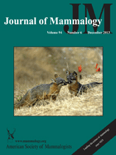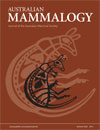
RUSSIAN JOURNAL OF THERIOLOGY
Scope & Guideline
Fostering Insights into Evolution and Behavior
Introduction
Aims and Scopes
- Mammalian Ecology and Behavior:
The journal emphasizes studies that explore the ecological roles and behaviors of various mammalian species, including their adaptations to diverse environments and social structures. - Conservation Biology:
Research published in the journal often addresses conservation strategies for endangered species, habitat preservation, and the impact of human activities on mammalian populations. - Genetics and Evolutionary Biology:
The journal features research on the genetic diversity and evolutionary history of mammals, contributing to the understanding of phylogeography and species differentiation. - Morphological and Anatomical Studies:
Publications often include detailed morphological analyses of mammals, which can provide insights into species identification, evolutionary relationships, and functional adaptations. - Population Dynamics and Community Ecology:
The journal covers studies on population trends, community structure, and the interactions between species, which are critical for understanding ecosystem health.
Trending and Emerging
- Non-invasive Monitoring Techniques:
Recent publications show a growing interest in non-invasive methods, such as photo-identification, for tracking endangered species. This trend is essential for minimizing human impact while obtaining critical data for conservation. - Genomic and Mitochondrial Studies:
There is an increasing focus on genomic analyses and mitochondrial DNA studies to understand genetic diversity and evolutionary relationships among mammalian species, which is crucial for effective conservation strategies. - Human-Wildlife Interactions:
Emerging research topics include the effects of human activities on mammalian behavior and ecology, indicating a heightened awareness of the anthropogenic impacts on wildlife. - Social Structures and Parental Care:
There is a notable trend towards investigating complex social structures and behaviors, such as alloparental care in rodents, reflecting a deeper interest in the social dynamics of mammals. - Climate Change Impacts:
Research addressing the effects of climate change on mammalian populations and their habitats is becoming more prevalent, underscoring the urgency of understanding how species adapt to changing environments.
Declining or Waning
- Historical and Paleontological Studies:
There has been a noticeable reduction in papers focusing on paleontological aspects and historical records of mammals, suggesting a shift towards contemporary ecological and conservation issues. - Generic Taxonomy without Modern Techniques:
Research that relies solely on traditional taxonomic methods without integrating modern genetic or morphological techniques appears to be less common, as the field moves towards more robust and interdisciplinary approaches. - Niche Studies on Common Species:
There seems to be a decline in studies exclusively focused on common mammalian species, as researchers increasingly prioritize endangered or lesser-known species that require urgent conservation attention.
Similar Journals

ANNALES ZOOLOGICI
Connecting Research and Conservation EffortsANNALES ZOOLOGICI is a distinguished academic journal published by the Museum & Institute of Zoology, Polish Academy of Sciences, based in Warsaw, Poland. With a long-standing tradition in zoological research, this journal has evolved to encompass a diverse range of studies in ecology, evolution, behavior, and systematics, aiming to foster a deeper understanding of animal biology and conservation. It holds a commendable Q2 classification in the 2023 Ecology, Evolution, Behavior and Systematics category, indicating its significant contribution to the field. Although ANNALES ZOOLOGICI is not an open-access publication, it remains accessible to a global audience of researchers, professionals, and students aiming to advance their knowledge and engage with cutting-edge zoological findings. As of 2024, this journal continues to be a vital resource for those eager to explore the complexities of animal life and contribute to ongoing discussions within this essential scientific discipline.

JOURNAL OF MAMMALOGY
Advancing the Frontiers of Mammalian ScienceJournal of Mammalogy, published by Oxford University Press Inc, is a premier journal dedicated to the field of mammalogy, providing a key platform for researchers and professionals interested in the biology, ecology, and conservation of mammals. With a prestigious impact factor reflected in its Q1 ranking in Animal Science and Zoology, and multiple Q2 rankings in related categories such as Ecology and Genetics for 2023, this journal is recognized for its significant contribution to advancing knowledge in the discipline. The journal features rigorous peer-reviewed articles, ensuring high-quality research output valuable for students, academia, and conservation efforts alike. While not an open-access journal, it offers comprehensive subscription options for institutions and individual readers, promoting accessibility to critical findings in the realm of mammal research. Established in the earlier years of the 20th century, the Journal of Mammalogy has continuously evolved, serving as an integral resource for disseminating innovative studies and insights that drive the future of mammalian sciences.

RUSSIAN JOURNAL OF NEMATOLOGY
Illuminating the Role of Nematodes in Ecosystem HealthRUSSIAN JOURNAL OF NEMATOLOGY, published by the Russian Academy of Sciences, Institute of Parasitology, serves as an essential platform for disseminating comprehensive research on nematodes and their ecological significance. With a strong foundation since its inception in 1996, this journal addresses critical areas within the fields of Animal Science and Zoology, as well as Ecology, Evolution, Behavior, and Systematics, currently positioned in the Q3 category for both domains. In 2023, the journal ranks #216 out of 490 in Animal Science and Zoology, and #387 out of 721 in Ecology, reflecting its growing impact within the scientific community. Though it is not an open-access journal, RUSSIAN JOURNAL OF NEMATOLOGY remains a pivotal resource for researchers, professionals, and students seeking to advance their understanding of nematological science, particularly in the context of ecological interactions and parasitic relationships. Each issue synthesizes innovative research findings that contribute to the broader discourse on biodiversity and ecosystem health.

Zoological Letters
Unlocking the mysteries of the animal kingdom.Zoological Letters, published by BMC, is a premier open-access journal dedicated to advancing the field of zoology and animal science. Since its inception in 2015, the journal has established itself as a critical platform for researchers to disseminate their findings and contribute to the ongoing discourse in this vibrant discipline. Based in the United Kingdom, Zoological Letters boasts an impressive Q2 category ranking in Animal Science and Zoology for 2023, placing it within the top 25% of journals in the field. With a Scopus rank of #116 out of 490, representing the 76th percentile, it showcases the influence and reach of the research published within its pages. The journal’s substantial focus on contemporary issues and methodologies ensures that it is a vital resource for academics, professionals, and students alike, fostering innovation and collaboration throughout the global scientific community. Open access since 2015, Zoological Letters is committed to making scientific knowledge accessible, thus enhancing the visibility and impact of research in zoological studies.

CANADIAN JOURNAL OF ZOOLOGY
Bridging Theory and Practice in Zoological ResearchWelcome to the Canadian Journal of Zoology, a leading academic journal in the fields of Animal Science and Zoology as well as Ecology, Evolution, Behavior and Systematics. Published by Canadian Science Publishing since 1965, this esteemed journal serves as a vital platform for researchers, professionals, and students to disseminate and engage with significant findings in zoological and ecological research. With an impact factor placing it in the Q2 category and rankings reflecting its influence (201/490 in Animal Science and Zoology; 372/721 in Ecology), the journal is committed to advancing the understanding of animal biology and environmental interactions. Although currently not an open access publication, it provides comprehensive resources and studies that are crucial for the academic community. Based in Ottawa, Canada, the journal continues to push the boundary of knowledge right up to 2024 and beyond, making it an essential resource for anyone dedicated to the life sciences.

BELGIAN JOURNAL OF ZOOLOGY
Advancing the Frontiers of Animal Science.The BELGIAN JOURNAL OF ZOOLOGY, published by the Royal Belgian Zoological Society, serves as a prominent platform for advancing research in the field of zoology. With an impact factor reflecting its status within the academic community, this journal rigorously publishes innovative studies and reviews, covering a broad spectrum of topics related to animal science and zoology. As an esteemed outlet, the journal ranks in the Q2 category for both Animal Science and Zoology, demonstrating its relevance and contribution to the field, as indicated by its Scopus ranking of 255 out of 490. Although it operates under a subscription model, the journal is committed to disseminating high-quality research that can shape contemporary understanding of animal biology and ecology. With a publication history dating back to 1990 and extending through 2024, researchers, professionals, and students are encouraged to engage with its rich content, which is vital for ongoing discourse and discovery within zoological sciences.

ZHURNAL OBSHCHEI BIOLOGII
Connecting Scholars Through Biological InsightsZHURNAL OBSHCHEI BIOLOGII, published by MEZHDUNARODNAYA KNIGA in the Russian Federation, is a venerable journal with a rich history originating in 1945. Renowned for its contributions to the fields of Ecology, Evolution, Behavior, and Systematics, as well as Medicine (miscellaneous), this journal provides a platform for researchers and professionals to disseminate significant findings within these domains. Although currently not classified as an open access publication, ZHURNAL OBSHCHEI BIOLOGII holds a Q4 quartile designation in its respective categories, reflecting its unique positioning within the global research landscape. While its coverage in Scopus is limited, the journal remains an important resource for academics interested in the evolution of biological sciences, especially within the context of Russian research traditions. By fostering scholarly communication and collaboration, ZHURNAL OBSHCHEI BIOLOGII continues to play a critical role in advancing knowledge in the biological sciences.

ACTA ZOOLOGICA
Contributing to the Future of Zoological ResearchACTA ZOOLOGICA, published by WILEY, is a distinguished journal that serves as an essential resource for researchers and professionals in the fields of Animal Science, Zoology, Cell Biology, and Ecology. With its ISSN 0001-7272 and E-ISSN 1463-6395, this journal has been contributing to the scientific community since 1920 and continues to explore new dimensions in zoological research. As of 2023, it holds an impactful position with a Q3 ranking in Animal Science and Zoology as well as Ecology, Evolution, Behavior and Systematics, signifying its relevance and emerging influence in these domains. Although it is not an Open Access journal, ACTA ZOOLOGICA remains committed to disseminating high-quality research and facilitating scholarly discussions among its audience. The journal aims to publish original articles, reviews, and critical findings that enhance understanding of animal biology and conservation, addressing global ecological challenges. Its rankings in Scopus further underscore its scholarly reputation, making it a valuable addition to the libraries of institutions and individuals alike.

AUSTRALIAN MAMMALOGY
Pioneering Research in Zoology and Evolutionary BiologyAustralian Mammalogy, published by CSIRO PUBLISHING, is a pivotal journal in the fields of Animal Science and Zoology as well as Ecology, Evolution, Behavior and Systematics. With its ISSN 0310-0049 and E-ISSN 1836-7402, this esteemed journal has been instrumental in disseminating critical research findings since 2000, and continues to evolve up to 2024. Ranked in the Q2 quartile of both its categories for 2023, it showcases a diverse array of studies that contribute to understanding Australia’s unique mammalian fauna and its ecological dynamics. Researchers, professionals, and students will find valuable insights in its peer-reviewed articles, which are essential for advancing knowledge in these essential scientific disciplines. Located in Australia at UNIPARK, Locked Bag 10, Clayton, VIC, this journal remains committed to fostering scholarly communication within the global scientific community.

Vertebrate Zoology
Fostering Collaboration in Animal ScienceVertebrate Zoology is a prestigious open-access journal published by the Staatliches Museum Tierkunde Dresden in Germany, focusing on the intricate and diverse field of animal biology. With an ISSN of 1864-5755, the journal has established itself as a vital resource for researchers, professionals, and students in the realms of Animal Science and Ecology, Evolution, Behavior, and Systematics. Since transitioning to open access in 2021, it has expanded accessibility and global dissemination of research findings, showcasing significant studies that contribute to our understanding of vertebrate fauna. The journal's impressive Q1 quartile rankings in both Animal Science and Zoology, as well as Ecology and Evolution, underscore its influence within the academic community—ranking #95 and #220 in their respective categories according to Scopus. Spanning from 2011 to 2024, Vertebrate Zoology aims to provide a comprehensive platform for innovative research, fostering collaboration and advancing knowledge across the biological sciences.